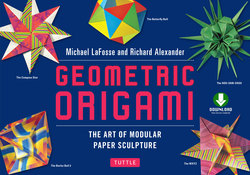Читать книгу Geometric Origami - Michael G. LaFosse - Страница 7
На сайте Литреса книга снята с продажи.
ОглавлениеIntroduction
Some of the most popular classes at our Origamido Studio in Massachusetts (and at our Origami Do Experience in Waikiki) involve multiple, interlocking pieces of folded paper. This field of “Geometric Origami” has grown in popularity as more origami practitioners in the fields of mathematics, engineering, and computer science have enriched the origami community with their stunning, innovative, folded designs. This collection represents some of the best-loved designs from these distinguished creators. The video provides you with repeatable private lessons on all of these projects. Using the “Pause” and “Play” features on your computer or player will allow you to learn at your own pace.
Folding modular elements requires skill to produce neat, precise and crisp folds. Technique is also important. Stacking each of the finished pieces also helps ensure that each is congruent (and not wrong-handed). Turning the piece as you fold each edge or flap away from you helps produce consistent folds. Perhaps it is easier for your brain to calibrate and refine the forces in your hands and fingers when the posture and motions are limited (at first by choice, and then by habit). The process of folding multiple pieces also provides repetition, so once you have folded a certain modular design, you might just remember how to fold it forever!
Modular origami designs span the world of folding, from a centuries-old craft, through the newer realm of folded art. Indeed, over the last few years, we have seen a marked increase in requests for
our custom paper that is heavy enough for use in modular constructions. While most modular designs are first constructed from inexpensive, commercially available papers, fine art exhibits of origami are now as likely to include modular designs folded from archival, custom, handmade papers.
This kit and Bonus Material provide the beginning folder with a series of fun, modular origami projects that represent a wide variety of subjects and techniques. Many of these projects are excellent for use in the classroom, for art, math or geometry investigations. Our hope is that you might experience some of the wonder and satisfaction that so many of our students have enjoyed during our decades of sharing and teaching origami.
Borloz Ball 1 & 2
